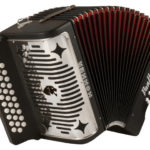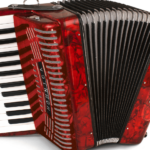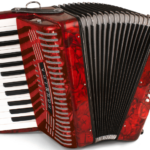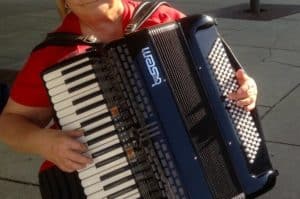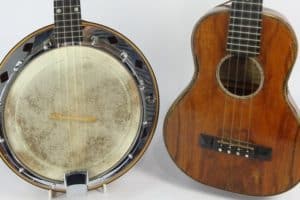At first glance, the accordion does look like a rather large, heavy instrument. But how heavy is it? How much does an accordion weigh?
An accordion usually weighs about 12 to 30 pounds (5.4 to 13.6 kg). Entry-level accordions are often lighter, weighing about 10 to 12 pounds. The weight of the accordion depends on its height, the number of keys (usually 20 to 41 on the right and 12 to 120 on the left), and the number of reeds (2 to 9).
Read on to learn more about how much an accordion weighs, different types of accordions and their weight, and some recommended accordions.
Also, we hope you find the links here useful. If you purchase something through a link on this page, we may get a commission, so thank you!
Also, for an excellent piano accordion for beginners, look at the Hohner BR48R-N 26-Key Piano Accordion. Hohner accordions have always been famous for their great sound, and this accordion is no exception. This accordion weighs about 15 lbs (6.8 kg):
Click here to see this Hohner accordion on Amazon.
For an excellent button accordion, take a look at the Tulskaya Garmon BN-41 Beginner Chromatic Button Accordion. This accordion produces a powerful bass sound and rich treble. It weighs about 13 lbs (5.9 kg):
Click here to see this button accordion on Amazon.
How Much Does an Accordion Weigh?
A typical accordion weighs about 12-30 pounds (5.4-13.6 kg). Entry-level accordions are often lighter, weighing about 10-12 pounds.
To play an accordion well, you should really consider buying an accordion that you can handle comfortably. And the accordion’s weight plays a part in this consideration. The table below shows the average weight of an accordion based on the number of bass buttons and number of reeds:
| Number of Bass Buttons and Reeds | Average Accordion Weight |
| 48 Bass (Two Sets of Reeds) | 11-13 pounds (5-6 kilos) |
| 72 Bass (Three Sets of Reeds) | 15-18 lbs (7-8.5 kilos) |
| 72 Bass (Four Sets of Reeds) | 17-20 Ibs (8-9 kilos) |
| 96 Bass (Four Sets of Reeds) | 20-22Ibs (9-10 kilos) |
| 120 Bass (Three sets of reeds) | 20-22Ibs (9-10 kilos) |
| 120 Bass (Four sets of reeds) | 23-24.5Ibs (10.5-11 kilos) |
| 120 Bass Cassotto (Four sets of reeds) | 24.5-28.5Ibs (11-13 kilos) |
Below is a recommended size guide for a standard accordion with 41 keys, depending on the user’s height. This guide is shown below:
| User Height | Recommended 41 Key Accordion Keyboard Size |
| 4’-4’10’’ | 14’’ to 15 & ¾” |
| 4’ 10’’- 5’3’’ | 16’’ to 16 & ½’’ |
| 5’-5’3’’ | 16 & ¾’’ to 17’’ |
| 5’3’’- 5’5’’ | 17 & ¼ ‘’ to 18’’ |
| 5’5’’-5’7’’ | 18 & ¼’’ to 18 & ¾’’ |
| 5’8’’ onwards | 19’’ to 19 & ½’’ |

Types of Accordions
There are different types of accordion available on the market nowadays. Below I’ll explain the differences as well as the average weight for each type.
Piano vs Button Accordions
The key difference between the piano and button accordion is that the right-hand side of an accordion can be made up of keys just like a keyboard, or they can be made up of buttons just like the left-hand side of an accordion.
Button accordions were made popular by a Scottish legend named Sir Jimmy Shand, while piano accordions became popular due to Guido Deiro and his Vaudeville performances.
The first button accordion is believed to have been first created by Franz Walther in Vienna in the year 1859. Button accordions are popular in European countries and other places where Europeans settled.
Piano accordions have about 25 to 45 treble keys, while the left side has a bass-chord pattern, also known as a Stradella system. Features of a full-size accordion include having 41 treble keys and about three or more octaves of notes, 120 bass buttons (or 140 for some accordions) with either a free bass, Stradella, or French 3-3 bass system.
The piano or button accordion weight depends on the number of keys as well as the number of reeds. They range from about 12 to 30 pounds (5.4 to 13.6 kg). Entry-level accordions are often much lighter, weighing about 10 to 12 pounds.
Piano accordions are said to be the most popular type of accordion in the U.S., and these types of accordions are usually utilized for music genres such as polka (and other European music), folk music, zydeco, country, Italian, German, Balkan music, and even rock. Its popularity may be a direct result of its versatility.
Unisonoric vs Bisonoric Accordions
The basis of these two types of accordions is the sound produced when the bellows are squeezed. A unisonoric accordion produces the same pitch that is consistent with whether you changed the direction of your bellow, whereas a bisonoric accordion can produce different notes if you push or pull the button present on your accordion.
Diatonic vs Chromatic Accordions
Diatonic accordions are usually classified as button accordions, and they are also usually made up of two or three rows of buttons. Each of these rows produces notes of one diatonic scale. Diatonic accordions are also usually bisonoric – meaning, a button produces two pitches depending on whether the bellow is being pushed or pulled. To play different keys, musicians need several instruments since each row only produces one key. Musical styles that make use of diatonic button accordion include Cajun and Norteño.
Chromatic button accordions are usually unisonoric – meaning, only one pitch is played whenever you pull or push the bellow. Chromatic button accordions have three to five rows of buttons arranged chromatically and can play any key, unlike the diatonic accordions. This type of accordion is famous in French musette music as well as Russian bayan music.
How Does an Accordion Work?
An accordion is played using two hands. The right-hand side of the accordion produces the melody, while the left-hand side produces the accompaniment. The bellows is the flexible component of the accordion that controls airflow.
Upon squeezing this part of the accordion, pressurized air passes through the different sets of reeds and escapes through the valve openings, producing notes. Note that the harder you press the bellow, the louder the sound produced, and the opposite is true as well. You should also note that a change in the direction of the bellow could also change the sound you can produce.
The reeds inside the accordion have different lengths and widths, resulting in different pitches. The bank of reeds is similar in appearance to wooden harmonicas. Underneath the reeds are the tone holes where the air passes before escaping through the valve openings.
An accordion’s voice can be controlled through the switches present on the instrument. As mentioned earlier, both sides of the bellow contain switches that can control the quality of voice coming from the instrument. The switches are capable of this functionality by closing or opening a set of reeds.
Many materials are used to make up the accordion, including metal, plastic, wood, and leather. The pallets, frame, and reed block are usually made of poplar wood, which is lightweight and sturdy.
The accordion bellow is usually made of strong cardboard and cloth, with metal and leather added. The material used will, of course, make the accordion heavier or lighter.
Recommended Accordions
When choosing an accordion, the first consideration should be the type of accordion you want to play – piano or button accordion. Then you should consider how many keys and buttons you want for your accordion. It is generally better to start with an entry-level accordion with not as many keys ad buttons.
The accordion weight should also be considered. Entry-level accordions won’t have as many keys and buttons, so they will be lighter in weight and more comfortable to use when starting out. Below is a list of the top 4 accordions we recommend, as well as how much each accordion weighs.
1. Hohner BR48R-N 26-Key Piano Accordion
The Hohner BR48R-N 26-Key Piano Accordion not only stands out due to its red color but also because of its great sound. Hohner accordions have always been famous for their distinctive sound.
Click here to see this Hohner accordion on Amazon.
This accordion contains 26 keys, 48 bass buttons, two-tone colors, two treble registers, and four standard bass voices. Its keyboard length is about 12.75 inches. The lowest note is B while the highest note is C. The accordion also comes with adjustable textile straps and a gig bag.
The weight of the Hohner BR48R-N accordion is about 15 pounds (approximately 6 kilos). The light weight of the accordion, the shape, and the comfortable straps make it easy to hold for a long time while standing up.
The amount of tremolo on this accordion can be modified. For beginners, the tremolo effect is the sound effect produced when two different notes have different pitches. Modifications can produce acoustic effects or other effects, depending on the amount of tuning done on the accordion.
This accordion is especially suited for music styles such as Jazz, Irish Folk, Zydeco, Tejano, Conjunto, Polka, Traditional, American Folk, Tex-Mex, Norteno, Irish Folk, Traditional English Music, Marches, Polka, Italian, Latin, Tango, Cajun, and many more.
2. Tulskaya Garmon 209 B-system Chromatic Button Accordion
The Bayan Tula 209 B-system Chromatic Button Accordion contains five rows, 92 treble buttons, and 100 bass buttons.
Click here to see this button accordion on Amazon.
It is a popular Russian button accordion made by reputable accordion maker Tulskaya Garmon. This accordion weighs about 18 pounds (or 8 kg) and has a 16.2×8.3×16.1 inches dimension. The accordion also comes with original straps and a soft case.
Bayan Tula’s 209 B-system Stradella underwent a multi-stage check to produce a rich treble sound and a deep bass sound to provide musicians with the best accordion for their concerts.
This accordion is a bit more advanced and heavier than other accordions on this list, but I’ve tried one before, and it felt very light and comfortable when standing up for a while.
3. Tulskaya Garmon BN-41 Beginner Chromatic Button Accordion
The Tulskaya Garmon BN-41 Beginner Chromatic Button Accordion contains three rows, 46 treble buttons, and 80 bass buttons producing a powerful bass sound and rich treble.
Click here to see this button accordion on Amazon.
While this accordion has these features, it is still made to be super lightweight with an approximate weight of 13 lbs or 6 kg. Its light weight makes it suitable for beginners and also children. This accordion also comes in different colors such as red, green, black, blue, and white.
4. Hohner A16631S Bravo Line Facelift III Chromatic Piano Accordion
The Bravo series by Hohner was made for people who want to start learning how to play the chromatic accordion and enjoy the various sounds a chromatic accordion can make. They are lightweight and have the perfect shape suitable for beginners.
While the accordions for this series are specially made for beginners, Hohner also added functionalities that can also be found in more advanced accordions.
The Hohner A16631S Bravo Line Facelift III Chromatic Piano Accordion is perfect for beginners and still includes all the features and quality of a more advanced accordion. The accordion contains 72 basses and three voices and weighs about 16.31 lbs.
Click here to see this Hohner accordion on Amazon.
Accordion FAQs
An accordion is a hand-held keyboard that is characterized as a wind instrument due to the hand-operated bellows connected to it. The accordion is played through the keys and buttons. Some musical genres which usually feature accordion include cajun music, zydeco, tango, conjunto, Tejano, Norteno, polka, Irish music, musette and chanson, Quebecois, and klezmer.
The left side of an accordion consists of the keyboard, while the right-hand side consists of the bass buttons. The bellow provides wind pressure inside the instrument that gets forced through the reeds. To switch how the reeds sound, a keyboard switch or buttons (keyboard reed selector) can be pushed. These buttons are also present on the right-hand side of the accordion but with a different function and that is to change the sound of the bass.
The name accordion originated from the German word “akkord,” which literally means musical chord. The first accordion was first invented in the 1800s in Berlin by Friedrich Buschmann. Its original name was Handäoline, and the reason behind its invention is to act as a cheaper replacement for pipe organs played in churches.
Afterward, Cyrillus Damian of Vienna changed its name to accordion upon adding buttons on the left-hand side of the instrument, which was meant to sound chords. The first batches of accordions invented contain diatonic buttons (buttons instead of keyboards). These accordions were quite heavy and bulky due to their solid wood construction.
An accordion is classified as a free-reed instrument, meaning the reeds vibrate once air passes through it; thus, making a sound. The first free-reed instrument was said to be first developed in China during the 2nd millennium BCE. This instrument, which is called Sheng, is still being played today.
The widespread manufacturing of accordions happened during the Industrial Revolution. During the 1920s, Hohner, a well-known accordion manufacturer in Europe, started printing classical musical sheets in an effort to veer away accordion’s reputation of being a folk instrument.
In addition to this effort, Hohner also opened up a school where playing accordion was taught. An orchestra was also formed, touring neighboring countries to promote the accordion as a classical instrument. Hohner also developed lighter accordions, including entry-level beginner accordions weighing only about 11 pounds, which was a welcome alternative to the heavier, bulkier versions.
Accordions are still being played up until today due to the richness of sound it produces and because it can be easily carried and relatively easy to play as compared to other instruments.
Conclusion – How Much Does an Accordion Weigh?
An accordion typically weighs between 12 to 30 pounds (5.4-13.6 kg). The accordion weight will vary based on various factors, such as its height, the number of keys (which is approximately 20-41 keys on the right and 12 to 120 keys on the left), and how many sets of reeds there are.
The materials used to make the accordion will also play a role in how much it weighs. There are many materials that go into the making of the accordion, including plastic, wood, metal, cloth, leather, and more. The wood frames of accordions are made of lightweight poplar wood, and the bellow is often made of strong cardboard and cloth, with leather and metals added.
If you are planning on purchasing an accordion, consider more than just the weight. Consider the arrangement of the buttons on the accordion as well as the shape and design. Happy playing!
Related reading:
Best Accordion – Top 10 Button and Piano Accordions
How Do Accordions Work? (Plus Accordion Parts)
Piano Accordion Vs Button Accordion – Key Differences
What Type of Accordion is Easier to Play: Button or Accordion?





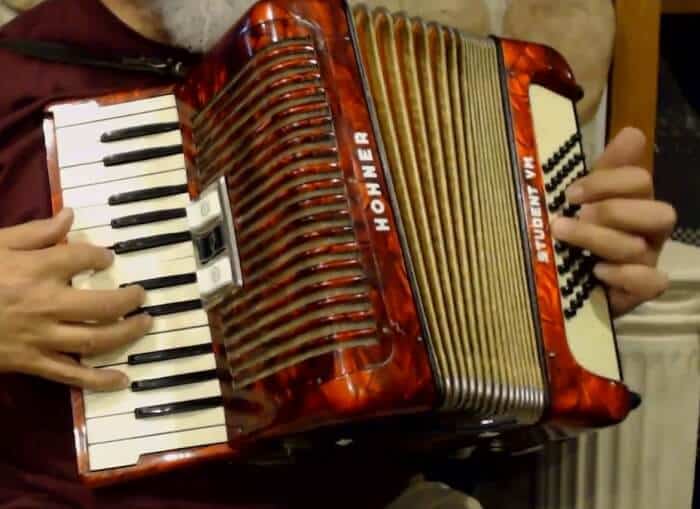
![Accordion-like Instruments [Full List] accordion like instruments](https://musicalinstrumentpro.com/wp-content/uploads/2022/09/accordion-like-instruments-150x150.jpg)
